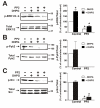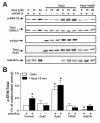Pyk2 uncouples metabotropic glutamate receptor G protein signaling but facilitates ERK1/2 activation
- PMID: 20180987
- PMCID: PMC2829546
- DOI: 10.1186/1756-6606-3-4
Pyk2 uncouples metabotropic glutamate receptor G protein signaling but facilitates ERK1/2 activation
Abstract
Group I metabotropic glutamate receptors (mGluRs) are coupled via Galphaq/11 to the activation of phospholipase Cbeta, which hydrolyzes membrane phospholipids to form inositol 1,4,5 trisphosphate and diacylglycerol. This results in the release of Ca2+ from intracellular stores and the activation of protein kinase C. The activation of Group I mGluRs also results in ERK1/2 phosphorylation. We show here, that the proline-rich tyrosine kinase 2 (Pyk2) interacts with both mGluR1 and mGluR5 and is precipitated with both receptors from rat brain. Pyk2 also interacts with GST-fusion proteins corresponding to the second intracellular loop and the distal carboxyl-terminal tail domains of mGluR1a. Pyk2 colocalizes with mGluR1a at the plasma membrane in human embryonic kidney (HEK293) cells and with endogenous mGluR5 in cortical neurons. Pyk2 overexpression in HEK293 results in attenuated basal and agonist-stimulated inositol phosphate formation in mGluR1 expressing cells and involves a mechanism whereby Pyk2 displaces Galphaq/11 from the receptor. The activation of endogenous mGluR1 in primary mouse cortical neuron stimulates ERK1/2 phosphorylation. Treatments that prevent Pyk2 phosphorylation in cortical neurons, and the overexpression of Pyk2 dominant-negative and catalytically inactive Pyk2 mutants in HEK293 cells, prevent ERK1/2 phosphorylation. The Pyk2 mediated activation of ERK1/2 phosphorylation is also Src-, calmodulin- and protein kinase C-dependent. Our data reveal that Pyk2 couples the activation mGluRs to the mitogen-activated protein kinase pathway even though it attenuates mGluR1-dependent G protein signaling.
Figures










Similar articles
-
Ca(2+)/calmodulin-dependent protein kinase II interacts with group I metabotropic glutamate and facilitates receptor endocytosis and ERK1/2 signaling: role of β-amyloid.Mol Brain. 2015 Mar 26;8:21. doi: 10.1186/s13041-015-0111-4. Mol Brain. 2015. PMID: 25885040 Free PMC article.
-
Metabotropic glutamate receptor 1-induced upregulation of NMDA receptor current: mediation through the Pyk2/Src-family kinase pathway in cortical neurons.J Neurosci. 2002 Jul 1;22(13):5452-61. doi: 10.1523/JNEUROSCI.22-13-05452.2002. J Neurosci. 2002. PMID: 12097497 Free PMC article.
-
Metabotropic glutamate receptor 5-induced phosphorylation of extracellular signal-regulated kinase in astrocytes depends on transactivation of the epidermal growth factor receptor.J Neurosci. 2001 Dec 15;21(24):9619-28. doi: 10.1523/JNEUROSCI.21-24-09619.2001. J Neurosci. 2001. PMID: 11739572 Free PMC article.
-
Mechanisms of metabotropic glutamate receptor desensitization: role in the patterning of effector enzyme activation.Neurochem Int. 2002 Nov;41(5):319-26. doi: 10.1016/s0197-0186(02)00073-6. Neurochem Int. 2002. PMID: 12176073 Review.
-
Phosphorylation of group I metabotropic glutamate receptors (mGluR1/5) in vitro and in vivo.Neuropharmacology. 2008 Sep;55(4):403-8. doi: 10.1016/j.neuropharm.2008.05.034. Epub 2008 Jun 10. Neuropharmacology. 2008. PMID: 18585398 Free PMC article. Review.
Cited by
-
Striatal-enriched protein tyrosine phosphatase (STEP) knockout mice have enhanced hippocampal memory.Eur J Neurosci. 2011 Jun;33(12):2288-98. doi: 10.1111/j.1460-9568.2011.07687.x. Epub 2011 Apr 19. Eur J Neurosci. 2011. PMID: 21501258 Free PMC article.
-
Ca(2+)/calmodulin-dependent protein kinase II interacts with group I metabotropic glutamate and facilitates receptor endocytosis and ERK1/2 signaling: role of β-amyloid.Mol Brain. 2015 Mar 26;8:21. doi: 10.1186/s13041-015-0111-4. Mol Brain. 2015. PMID: 25885040 Free PMC article.
-
The Implication of STEP in Synaptic Plasticity and Cognitive Impairments in Alzheimer's Disease and Other Neurological Disorders.Front Cell Dev Biol. 2021 Jun 14;9:680118. doi: 10.3389/fcell.2021.680118. eCollection 2021. Front Cell Dev Biol. 2021. PMID: 34195199 Free PMC article. Review.
-
Silent Allosteric Modulation of mGluR5 Maintains Glutamate Signaling while Rescuing Alzheimer's Mouse Phenotypes.Cell Rep. 2017 Jul 5;20(1):76-88. doi: 10.1016/j.celrep.2017.06.023. Cell Rep. 2017. PMID: 28683325 Free PMC article.
-
Orchestrated activation of mGluR5 and CB1 promotes neuroprotection.Mol Brain. 2016 Aug 20;9(1):80. doi: 10.1186/s13041-016-0259-6. Mol Brain. 2016. PMID: 27543109 Free PMC article.
References
Publication types
MeSH terms
Substances
LinkOut - more resources
Full Text Sources
Other Literature Sources
Molecular Biology Databases
Research Materials
Miscellaneous

